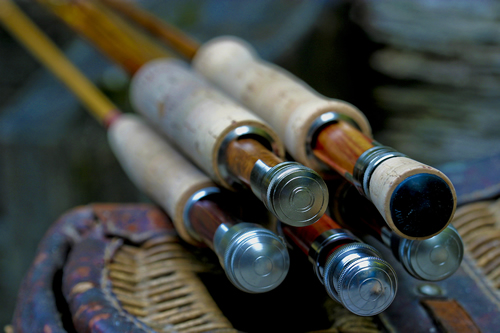- Home ›
- Bamboo Rods ›
- Bamboo Fly Rod Building
Bamboo Fly Rod Building and Making a Bamboo Fly Rod Overview
Bamboo fly rod building, the making of good quality fishing rods from bamboo cane, is a highly skilled craft.
There is a step by step overview of this rod making craft further down the page. It involves; splitting culms into strips, planing them, gluing the strips back together to make blanks, wrapping the guides, varnishing, and making the cork grip and seat for the reel.
Making Fishing Rods

Before you start out on a making a bamboo fly rod project it is a good idea to get the best advice out of the published works of masters of the craft. After all, you want to end up with well-crafted rods that are going to do an excellent job of catching fish!
As an Amazon Associate I earn from qualifying purchases (at no extra cost to you)
Bamboo Fly Rod Building Books for sale #ad
I have another page dedicated to book reviews for you to visit when you have finished here.
Bamboo Rod Building Books
Rod Building Events
The International Custom Rod Building Exposition
Bamboo Rod Species Recommendation
For building bamboo fly rods Tonkin Cane (Pseudosasa amabilis) is a species used most often out of over one thousand that are available to choose from. Another species often used for crafting bamboo rods is Calcutta Cane.
Tonkin Cane fibres have a high density and the species comes recommended due to strength, and the suitable flexibility needed for fishing rods. Tonkin bamboo cane nodes also have good spacing for rod building and use over alternative species of bamboo.
Bamboo Fly Rod Blanks
If you are keen to make your own fishing rods but do not want to build the blank, buying a blank to start you off with crafting your own is just the thing. You can buy blanks and hardware separately and outfit the rods yourself.
See my page on bamboo fly rod blanks - Bamboo Rod Building Books
Buy bamboo blanks on Amazon - Buy rod blanks on eBay. US
(As an eBay Partner, I may be compensated if you make a purchase)
Making a Bamboo Fly Rod
Making a bamboo fly rod is a highly specialised and intricate process that requires skill, patience, and a dedicated workspace.
I am not an expert but I can provide this simplified overview of the steps involved in making a bamboo fly rod to give you an idea of the work involved. You can then decide if you are that interested in the craft and perhaps buy some books on it for more detailed information from skilled bamboo rod makers:
Materials and Tools:
Bamboo Culms: You'll need bamboo canes of the appropriate species (Tonkin Cane Pseudosasa amabilis), Calcutta, or others) and size for the rod you want to make.
Tools: Traditional hand tools like a planing form, a binder, a heat source, various hand planes, a file, a measuring tape, and a drying cabinet are necessary.
Step 1: Select and Prepare the Bamboo
- Select Suitable Bamboo Culms: Choose bamboo canes that are straight, without any knots, and have the right dimensions for your desired rod length and line weight.
- Curing: Dry the bamboo culms for several months to reduce moisture content and improve flexibility.
Step 2: Split the Bamboo
- Split the Culms: Split the culms lengthwise into triangular strips, called splines.
Step 3: Straighten and Heat-Treat the Strips
- Straighten Strips: Remove any twists or bends from the strips.
- Heat-Treat: Heat-treat the strips to remove residual moisture and improve their properties.
Step 4: Taper the Strips
- Tapering: Using a planing form and hand planes, gradually reduce the thickness of each strip from butt to tip, creating a specific taper design for the rod.
Step 5: Glue the Strips
- Glue-Up: Apply glue to the strips and bind them together. Allow the glued strips to dry and cure for a specific time.
Step 6: Plane the Rod Blank
- Planing: Use hand planes to shape the glued-up strips into a round, smooth, and tapered rod blank.
Step 7: Ferruling and Reel Seat
- Ferrules: Attach ferrules (metal joints) to the rod sections.
- Reel Seat: Install the reel seat and cork grip.
Step 8: Wrapping and Finishing
- Wrapping: Wrap guides and the ferrule with thread to secure them to the rod blank.
- Varnishing: Apply multiple coats of varnish to protect and finish the rod. Allow each coat to dry thoroughly.
- Finish Sanding: Sand the rod to achieve a smooth, polished finish.
Step 9: Assemble and Test
- Assemble the Sections: Assemble the rod sections, ensuring they fit together properly.
- Testing: Test the rod's action and ensure it meets your intended line weight and casting performance.
Step 10: Final Touches
- Trim and Clean: Trim any excess wraps and clean up the rod's finish.
- Rod Bag and Tube: Craft a protective rod bag and tube for storage and transportation.
It's important to note that making a bamboo fly rod is a time-consuming and intricate process that often takes years to master. Many rod makers learn from experienced mentors or through dedicated craftsmanship courses. If you're interested in making your own bamboo fly rod, consider seeking out resources, books, and experts in the field to help you develop your skills.
Bamboo Fly Rod Building Books for sale - Amazon #ad
Bamboo Rod Building Books - this site
Fly Rods for Sale
Bamboo Fly Rod for sale on Amazon #ad
Bamboo Fishing Rods - eBay (As an eBay Partner, I may be compensated if you make a purchase)